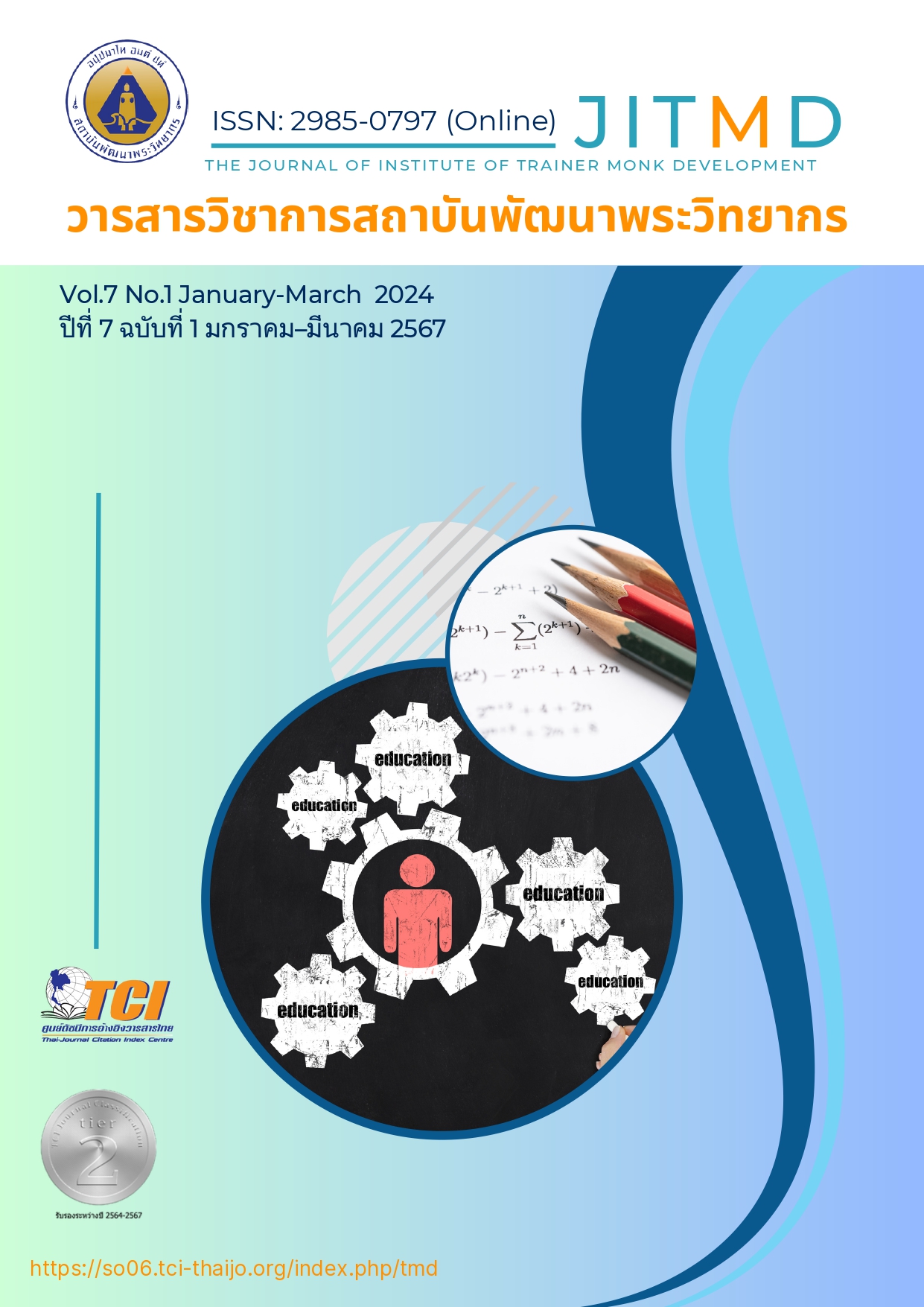A Comparison of English Learning Achievement on Passive Voice of Mattayomsuksa 5 Students by Using Flipped Classroom and Traditional Teaching Method
Main Article Content
Abstract
The objectives of this research were 1) to compare the English learning achievement on Passive Voice before and after teaching by using the traditional teaching method 2) to compare the English learning achievement on Passive Voice before and after teaching by using the flipped classroom and 3) to compare the English learning achievement on Passive Voice before and after teaching by using the flipped classroom and the traditional teaching method. The samplings in this research were 76 ISM program students, consisting of Matthayomsuksa 5/2, 38 students and Matthayomsuksa 5/3, 38 students, enrolled in the first semester of the 2023 academic year. They were selected by using a purposive sampling method. The research instruments were 1) two lesson plans using the flipped classroom 2) an online classroom on Google Classroom on Passive Voice, Basic English, EN32101 3) two lesson plans using the traditional teaching method, and 4) the pre-test and the post-test on Passive Voice (20 items). The findings were as follows: 1. Mattayomsuksa 5/2 students who were taught by using the traditional teaching method had higher scores on the post-test scores than those of the pre-test at the significant level of .05. 2. Mattayomsuksa 5/3 students who were taught by using the flipped classroom had higher scores on the post-test scores than those of the pre-test at the significant level of .05. 3. Mattayomsuksa 5 students who were taught by using the flipped classroom had higher post-test scores than those who were taught by the traditional teaching method at the significant level of .05.
Article Details

This work is licensed under a Creative Commons Attribution-NonCommercial-NoDerivatives 4.0 International License.
บทความที่ได้รับการตีพิมพ์เป็นลิขสิทธิ์ของวารสารวิชาการสถาบันพัฒนาพระวิทยากร
ข้อความที่ปรากฎอยู่ในบทความที่ได้รับการตีพิมพ์ในวารสาร ถือเป็นความรับผิดชอบของผู้เขียนบทความ และข้อคิดเห็นนั้นไม่ถือว่าเป็นทัศนะและความรับผิดชอบของกองบรรณาธิการวารสารวิชาการสถาบันพัฒนาพระวิทยากร
References
กระทรวงศึกษาธิการ. (2551). หลักสูตรแกนกลางการศึกษาขั้นพื้นฐาน พุทธศักราช 2551. กรุงเทพมหานคร: โรงพิมพ์ชุมนุมสหกรณ์การเกษตรแห่งประเทศไทย จำกัด.
คณิสรัชต์ กองแสน และอังคณา อ่อนธานี. (2565). การพัฒนากิจกรรมการเรียนรู้ตามแนวคิดห้องเรียนกลับด้านเพื่อพัฒนาความสามารถในการฟังและการพูดภาษาอังกฤษสำหรับนักเรียนชั้นประถมศึกษาปีที่ 6. วารสารวิชาการ มจร บุรีรัมย์, 7(1): 117-118.
จิรายุ ชูอิน และจุไรรัตน์ ลักษณะศิริ. (2561). การเปรียบเทียบผลสัมฤทธิ์ทางการเรียนเรื่องชนิดของคำของนักเรียนระดับชั้นมัธยมศึกษาปีที่ 1 โรงเรียนวัดสุทธิวรารามที่ได้รับการสอนโดยการเรียนแบบร่วมมือเทคนิค TGT กับการสอนแบบปกติ. รายงานการวิจัย. มหาวิทยาลัยรามคำแหง.
ชาคร ชีวาเกียรติยิ่งยง และสิงห์คํา รักป่า. (2563). การเสริมสร้างความรู้ด้านกรรมวาจกโดยใช้บทเรียนเสริมผ่าน Google Classroom. วารสารวิชาการมนุษยศาสตร์และสังคมศาสตร์มหาวิทยาลัยราชภัฏธนบุรี, 3(3): 37-39.
ชโลธร เทศสา และธนชาติ หล่อนกลาง. (2564). ผลของการสอนภาษาอังกฤษโดยใช้การเรียนรู้แบบห้องเรียนกลับด้านด้วยกูเกิลไซต์ต่อความสามารถในการฟังของนักเรียนชั้นมัธยมศึกษาปีที่ 5.วารสารชุมชนวิจัย มหาวิทยาลัยราชภัฏนครราชสีมา, 16(2): 235-238.
ฐานิตา ลิ่มวงศ์ และยุพาภรณ์ แสงฤทธิ์. (2562). ห้องเรียนกลับด้าน: การเรียนรู้แนวใหม่สำหรับศตวรรษที่ 21. วารสาร Mahidol R2R e-Journal, 6(2): 10-17.
บุษบา มหาชัย. (2564). Flipped Classroom หรือห้องเรียนกลับด้าน. สืบค้นข้อมูลเมื่อ 25 ธันวาคม 2565 จาก https://inskru.com.
ภัทราทิพย์ ธงวาส. (2562). การพัฒนาชุดกิจกรรมการเรียนการสอนร่วมกับกระบวนการจัดการเรียนรู้แบบห้องเรียนกลับด้านเพื่อพัฒนาทักษะการฟังและการพูดภาษาอังกฤษสำหรับนักเรียนชั้นมัธยมศึกษาปีที่ 2. รายงานการวิจัย. มหาวิทยาลัยนเรศวร.
เมธาวี ปัญญาจันทร์สว่าง และสุรัตนา อดิพัฒน์. (2565). การพัฒนาผลสัมฤทธิ์การเรียนรู้คำศัพท์ภาษาอังกฤษ โดยการจัดการเรียนรู้แบบห้องเรียนกลับด้านสำหรับนักเรียนระดับชั้นมัธยมศึกษาปีที่ 3. Journal of Roi Kaensarn Academi, 7(6): 106-108.
สุวโรจน์ เกียรติพัฒนไกร. (2553). การสอนไวยากรณ์ภาษาอังกฤษตามแนวสรรคนิยม สารนิพนธ์. บัณฑิตวิทยาลัย: มหาวิทยาลัยศรีนครินทรวิโรฒ.
Burin Pincharoen and Angvarrah Lieungnapar. (2562). The comparison of passive voices between TOEIC and TOEFL tests. ในการประชุมวิชาการนำเสนอผลงานวิจัยระดับชาติของนักศึกษาด้านมนุษย์ศาสตร์และสังคมศาสตร์ ครั้งที่ 2 ประจำปี 2562 (น.504-505). กรุงเทพมหานคร: มหาวิทยาลัยราชภัฏสวนสุนันทา.
Chonthita Phuwarat and Nirachorn Boonchukusol. (2563). THE ROLE OF GRAMMAR TEACHING IN ESL WRITING. วารสารวิชาการศรีปทุม ชลบุรี, 16(4): 1-3.
Abedi et al., (2019). The Comparative Effect of Flipped Classroom Instruction versus Traditional Instruction on Iranian Intermediate EFL Learners' English Composition Writing. Retrieved [05 May 2023] from https://www.researchgate.net.
Altas and Mede. (2021). THE IMPACT OF FLIPPED CLASSROOM APPROACH ON THE WRITING ACHIEVEMENT AND SELF-REGULATED LEARNING OF PRE-SERVICE ENGLISH TEACHERS. Turkish Online Journal of Distance Education-TOJDE, 22(1): 66-69.
Fathi and Rahimi. (2020). Examining the impact of flipped classroom on writing complexity, accuracy, and fluency: a case of EFL students. Retrieved [05 May 2023] from https://www.researchgate.net.
Fathi et al., (2022). A preliminary study on flipping an English as a foreign language collaborative writing course with video clips: Its impact on writing skills and writing motivation. Journal of Computer Assisted Learning, 39(1): 1-2.
Naem and Al-Amri. (2022). Saudi EFL University Students' perceived Linguistic Gains and Learning Experiences in Flipped Classrooms. Arab World English Journal (AWEJ) Special Issue on CALL, (8): 192-204.
Sharom and Si Na. (2022). The Effects of the Flipped Classroom on Primary School Students' Writing Performance in English. International Journal of Computer-Assisted Language Learning and Teaching, 12(1): 1-22.


